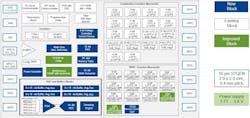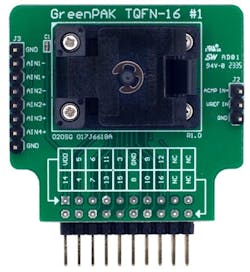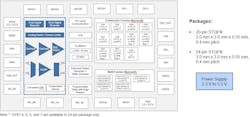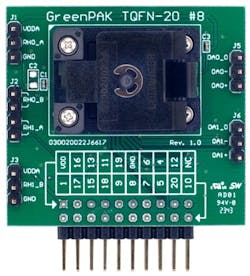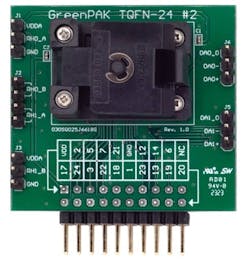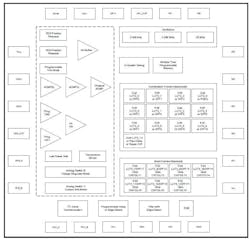Renesas Introduces AnalogPAK Mixed-Signal Baby-FPGAs
Led by the industry’s first programmable 14-bit successive-approximation-register analog-to-digital converter (SAR ADC), four new AnalogPAK ICs unveiled by Renesas Electronics also include lower-power and automotive-qualified devices.
These can be thought of as baby-FPGAs that feature a small number of lookup tables (LUTs) and a math block to enable programmable digital functions. However, they also feature analog programmable components such as comparators, op amps, ADC and digital-to-analog converter (DAC), filters, a temperature sensor, etc. All four products, along with evaluation/programming boards, are currently available from distributors.
Renesas will demonstrate these new AnalogPAK devices at the electronica Trade Fair from November 12-15, 2024 in Munich – Hall B4, Stand #179.
AnalogPAK SLG47011: Low-Power Device with 14-bit SAR ADC
The SLG47011 AnalogPAK device delivers a new level of performance for configurable analog integrated circuits. It includes a rich set of digital and analog features, including a programmable, multichannel 14-bit SAR ADC with programmable gain amplifier (PGA). The SLG47011 also has flexible, user-defined, power-saving modes for all macrocells, enabling designers to switch off some blocks in sleep mode and therefore reduce power consumption to the microamp level.
The SLG47011 can extend the performance of, or be utilized to offload, an MCU. It may also be used with an MCU to replace a complex analog front-end (AFE). Key functions supported by the SLG47011 include measurement, data processing, logic control, and data output.
Among the key parameters of SLG47011 are:
- Vdd = 1.71 to 3.6 V
- SAR ADC: Up to 14-bit, up to 2.35 Msamples/s in 8-bit mode
- PGA: Six amplifier configurations, rail-to-rail input/output, 1X to 64X gain
- DAC: 12 bit, 333 ksamples/s
- Hardware math block for multiplication, addition, subtraction, and division operations
- Flexible 4096-word memory table block
- Oscillators: 2/10 kHz and 20/40 MHz
- Analog temperature sensor
- Highest number of highly configurable counter/delay blocks
- I2C and SPI communication interfaces
- Tiny 16-pin QFN 2.0- × 2.0- × 0.55-mm, 0.4-mm-pitch package
The datasheet can be found here.
SLG47001/3 AnalogPAK Devices
The SLG47001 and SLG47003 enable the implementation of precise measurement systems with a low price point and a very compact package. Among their many applications are gas sensors, power meters, measurement equipment, servers, wearables, industrial robots, and industrial and smart-home sensor modules.
Features include:
- Two ultra-low-offset op amps: 9 µV (max.)
- Two 10-bit digital rheostats
- Six-channel sampling comparator
- Analog switch
- Voltage reference
- 59-byte pattern generator
- 2k/10k/25-MHz oscillators
- Fully configurable blocks: LUTs, flip-flops, shift registers, timers, counters, delays
- Available packages: 20-pin STQFN—2.0 × 3.0 × 0.55 mm, 0.4-mm pitch (SLG47001); 24-pin STQFN—3.0 × 3.0 × 0.55 mm, 0.4-mm pitch (SLG47003)
The datasheet can be found here.
SLG47004-A AnalogPAK Device
The SLG47004-A delivers the functionality of the SLG47004 devices with the addition of automotive qualification Grade 1 for applications such as infotainment, navigation, chassis and body electronics, automotive display clusters, and more. The new devices support a temperature range of –40 to 125°C.
The datasheet can be found here.
Product Overview Presentation
Editor’s note: I had Renesas brief me on the product line last week with a presentation during our recorded Zoom call, which gave me the opportunity to ask them some unprepared questions. Here’s the video recording of that Zoom call. If you’re unfamiliar with Renesas’ very-low-cost baby-FPGAs that have op amps, comparators, an ADC, and other analog blocks in addition to various LUTs, I think it’s a good overview of what’s in the chips. It also shows how their configuration tool is used.
Product briefing by Renesas.
Andy's Nonlinearities blog arrives the first and third Monday of every month. To make sure you don't miss the latest edition, new articles, or breaking news coverage, please subscribe to our Electronic Design Today newsletter.
About the Author
Andy Turudic
Technology Editor, Electronic Design
Andy Turudic is a Technology Editor for Electronic Design Magazine, primarily covering Analog and Mixed-Signal circuits and devices. He holds a Bachelor's in EE from the University of Windsor (Ontario Canada) and has been involved in electronics, semiconductors, and gearhead stuff, for a bit over a half century.
"AndyT" brings his multidisciplinary engineering experience from companies that include National Semiconductor (now Texas Instruments), Altera (Intel), Agere, Zarlink, TriQuint,(now Qorvo), SW Bell (managing a research team at Bellcore, Bell Labs and Rockwell Science Center), Bell-Northern Research, and Northern Telecom and brings publisher employment experience as a paperboy for The Oshawa Times.
After hours, when he's not working on the latest invention to add to his portfolio of 16 issued US patents, he's lending advice and experience to the electric vehicle conversion community from his mountain lair in the Pacific Northwet[sic].
AndyT's engineering blog, "Nonlinearities," publishes the 1st and 3rd monday of each month. Andy's OpEd may appear at other times, with fair warning given by the Vu meter pic.


